Hero Honda's Dividend Policies: A Deep Dive into Payout Strategies
VerifiedAdded on 2020/06/04
|12
|3227
|100
Essay
AI Summary
This essay provides an in-depth analysis of dividend theories, focusing on their application to Hero Honda's financial strategies. It explores various dividend theories, including dividend signaling and dividend smoothing, and examines how these theories influence the company's capital structure and payout policies. The essay delves into the importance of capital structure, risk, and return, and how these factors impact Hero Honda's investment decisions. It also discusses the company's dividend history, lifecycle, and how its payout policies have evolved over time. Furthermore, the essay provides a critical assessment of the relationship between dividend decisions and shareholder wealth, offering insights into how Hero Honda navigates the complexities of financial management to maximize shareholder value. The analysis draws upon relevant literature and financial data to support its arguments, providing a comprehensive understanding of the financial strategies employed by Hero Honda.

Essay
Paraphrase This Document
Need a fresh take? Get an instant paraphrase of this document with our AI Paraphraser
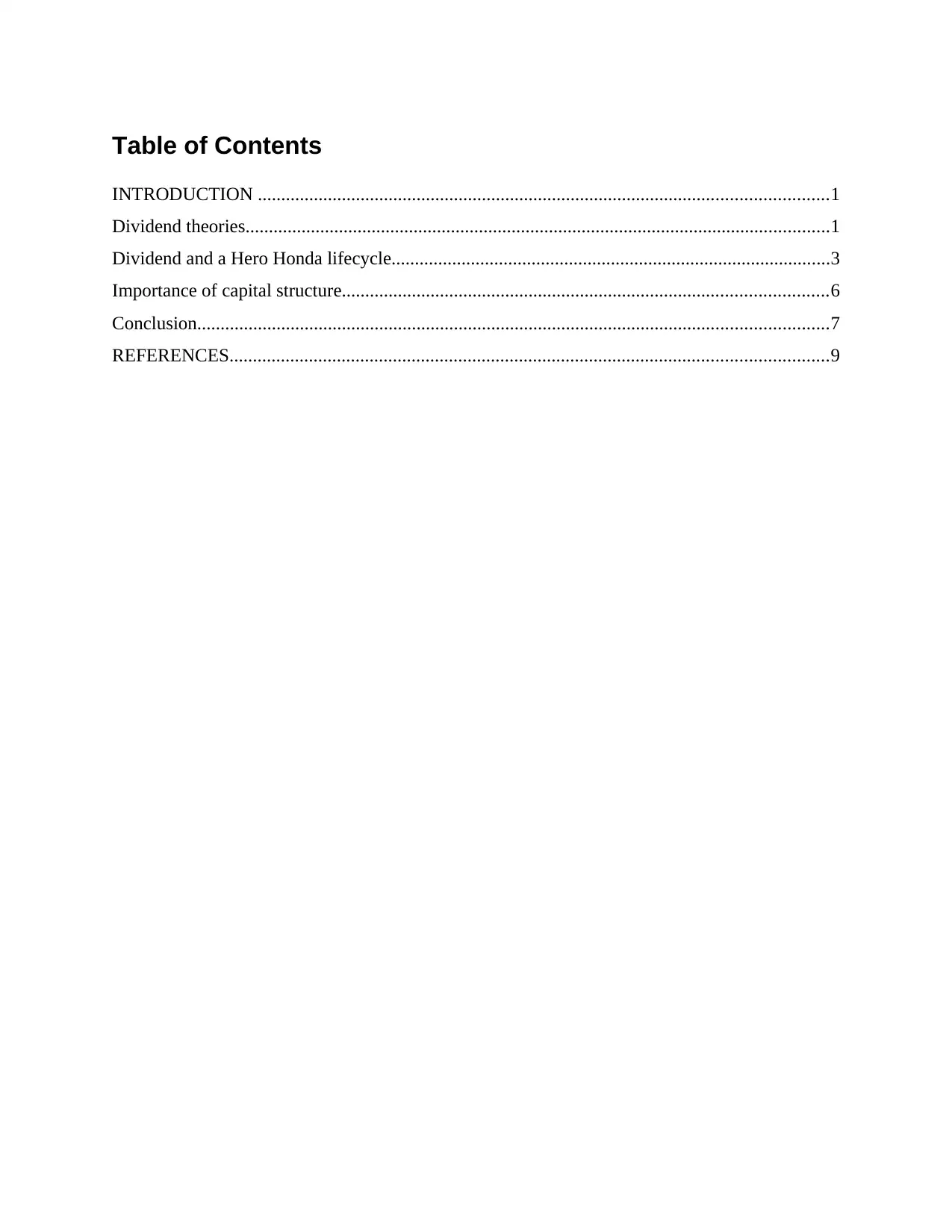
Table of Contents
INTRODUCTION ..........................................................................................................................1
Dividend theories.............................................................................................................................1
Dividend and a Hero Honda lifecycle..............................................................................................3
Importance of capital structure........................................................................................................6
Conclusion.......................................................................................................................................7
REFERENCES................................................................................................................................9
INTRODUCTION ..........................................................................................................................1
Dividend theories.............................................................................................................................1
Dividend and a Hero Honda lifecycle..............................................................................................3
Importance of capital structure........................................................................................................6
Conclusion.......................................................................................................................................7
REFERENCES................................................................................................................................9
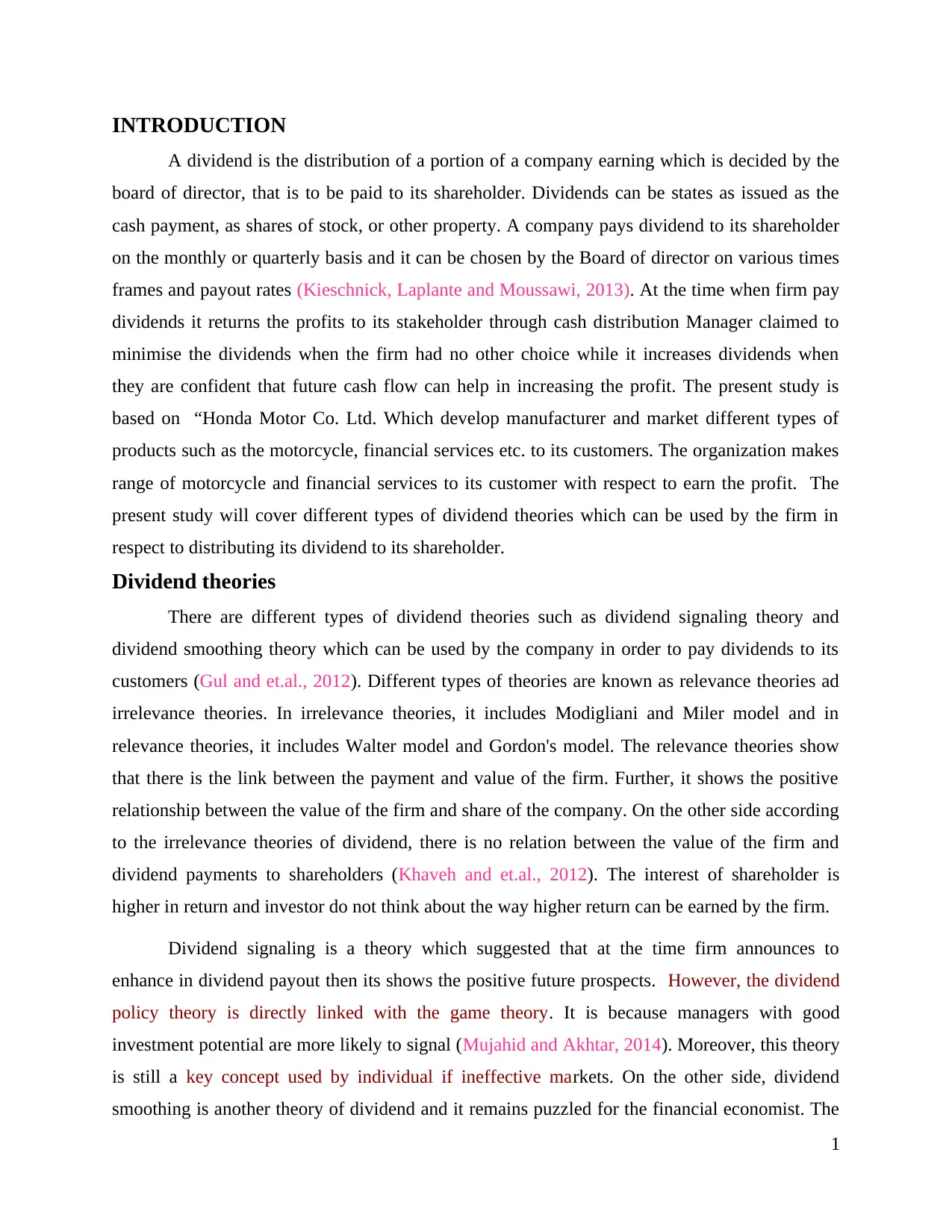
INTRODUCTION
A dividend is the distribution of a portion of a company earning which is decided by the
board of director, that is to be paid to its shareholder. Dividends can be states as issued as the
cash payment, as shares of stock, or other property. A company pays dividend to its shareholder
on the monthly or quarterly basis and it can be chosen by the Board of director on various times
frames and payout rates (Kieschnick, Laplante and Moussawi, 2013). At the time when firm pay
dividends it returns the profits to its stakeholder through cash distribution Manager claimed to
minimise the dividends when the firm had no other choice while it increases dividends when
they are confident that future cash flow can help in increasing the profit. The present study is
based on “Honda Motor Co. Ltd. Which develop manufacturer and market different types of
products such as the motorcycle, financial services etc. to its customers. The organization makes
range of motorcycle and financial services to its customer with respect to earn the profit. The
present study will cover different types of dividend theories which can be used by the firm in
respect to distributing its dividend to its shareholder.
Dividend theories
There are different types of dividend theories such as dividend signaling theory and
dividend smoothing theory which can be used by the company in order to pay dividends to its
customers (Gul and et.al., 2012). Different types of theories are known as relevance theories ad
irrelevance theories. In irrelevance theories, it includes Modigliani and Miler model and in
relevance theories, it includes Walter model and Gordon's model. The relevance theories show
that there is the link between the payment and value of the firm. Further, it shows the positive
relationship between the value of the firm and share of the company. On the other side according
to the irrelevance theories of dividend, there is no relation between the value of the firm and
dividend payments to shareholders (Khaveh and et.al., 2012). The interest of shareholder is
higher in return and investor do not think about the way higher return can be earned by the firm.
Dividend signaling is a theory which suggested that at the time firm announces to
enhance in dividend payout then its shows the positive future prospects. However, the dividend
policy theory is directly linked with the game theory. It is because managers with good
investment potential are more likely to signal (Mujahid and Akhtar, 2014). Moreover, this theory
is still a key concept used by individual if ineffective markets. On the other side, dividend
smoothing is another theory of dividend and it remains puzzled for the financial economist. The
1
A dividend is the distribution of a portion of a company earning which is decided by the
board of director, that is to be paid to its shareholder. Dividends can be states as issued as the
cash payment, as shares of stock, or other property. A company pays dividend to its shareholder
on the monthly or quarterly basis and it can be chosen by the Board of director on various times
frames and payout rates (Kieschnick, Laplante and Moussawi, 2013). At the time when firm pay
dividends it returns the profits to its stakeholder through cash distribution Manager claimed to
minimise the dividends when the firm had no other choice while it increases dividends when
they are confident that future cash flow can help in increasing the profit. The present study is
based on “Honda Motor Co. Ltd. Which develop manufacturer and market different types of
products such as the motorcycle, financial services etc. to its customers. The organization makes
range of motorcycle and financial services to its customer with respect to earn the profit. The
present study will cover different types of dividend theories which can be used by the firm in
respect to distributing its dividend to its shareholder.
Dividend theories
There are different types of dividend theories such as dividend signaling theory and
dividend smoothing theory which can be used by the company in order to pay dividends to its
customers (Gul and et.al., 2012). Different types of theories are known as relevance theories ad
irrelevance theories. In irrelevance theories, it includes Modigliani and Miler model and in
relevance theories, it includes Walter model and Gordon's model. The relevance theories show
that there is the link between the payment and value of the firm. Further, it shows the positive
relationship between the value of the firm and share of the company. On the other side according
to the irrelevance theories of dividend, there is no relation between the value of the firm and
dividend payments to shareholders (Khaveh and et.al., 2012). The interest of shareholder is
higher in return and investor do not think about the way higher return can be earned by the firm.
Dividend signaling is a theory which suggested that at the time firm announces to
enhance in dividend payout then its shows the positive future prospects. However, the dividend
policy theory is directly linked with the game theory. It is because managers with good
investment potential are more likely to signal (Mujahid and Akhtar, 2014). Moreover, this theory
is still a key concept used by individual if ineffective markets. On the other side, dividend
smoothing is another theory of dividend and it remains puzzled for the financial economist. The
1
You're viewing a preview
Unlock full access by subscribing today!
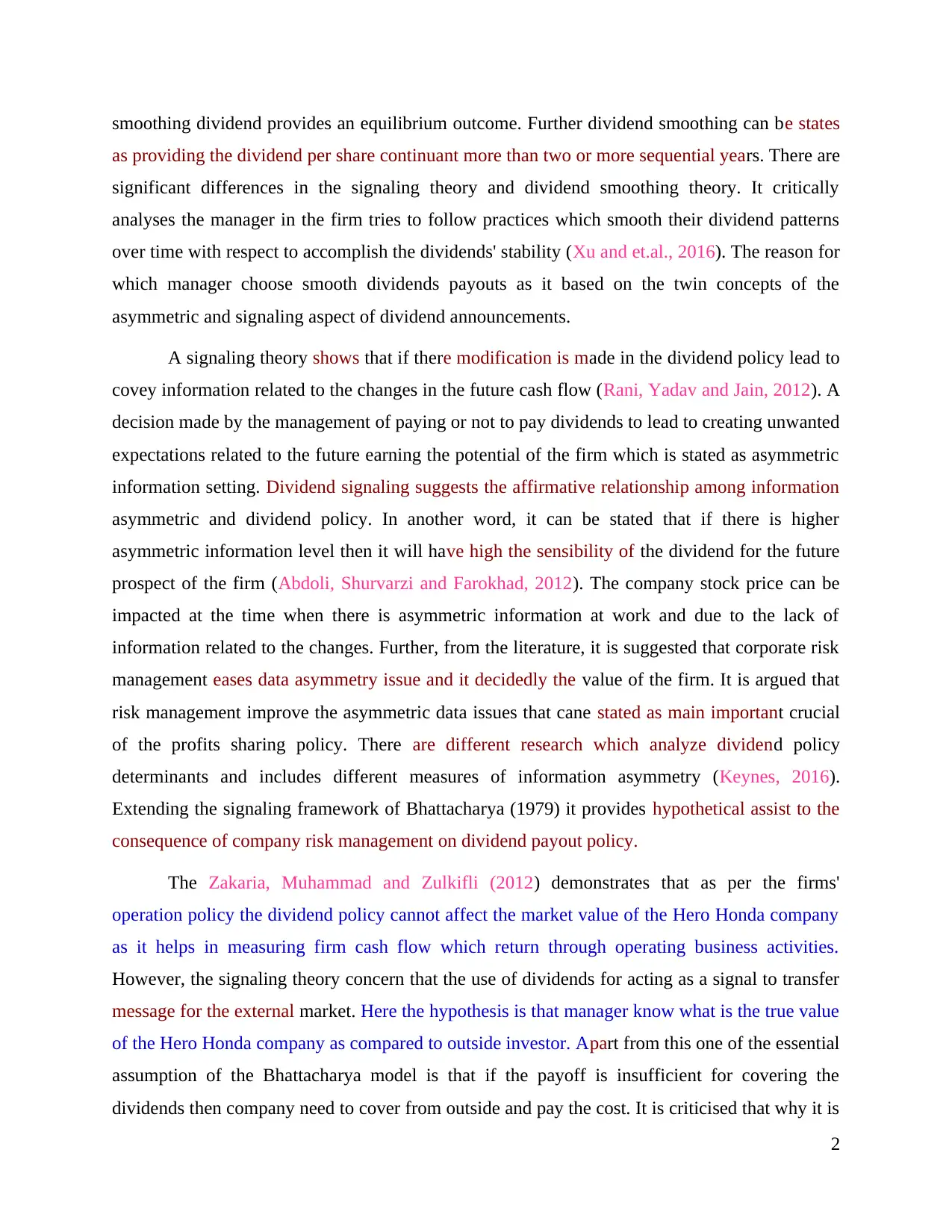
smoothing dividend provides an equilibrium outcome. Further dividend smoothing can be states
as providing the dividend per share continuant more than two or more sequential years. There are
significant differences in the signaling theory and dividend smoothing theory. It critically
analyses the manager in the firm tries to follow practices which smooth their dividend patterns
over time with respect to accomplish the dividends' stability (Xu and et.al., 2016). The reason for
which manager choose smooth dividends payouts as it based on the twin concepts of the
asymmetric and signaling aspect of dividend announcements.
A signaling theory shows that if there modification is made in the dividend policy lead to
covey information related to the changes in the future cash flow (Rani, Yadav and Jain, 2012). A
decision made by the management of paying or not to pay dividends to lead to creating unwanted
expectations related to the future earning the potential of the firm which is stated as asymmetric
information setting. Dividend signaling suggests the affirmative relationship among information
asymmetric and dividend policy. In another word, it can be stated that if there is higher
asymmetric information level then it will have high the sensibility of the dividend for the future
prospect of the firm (Abdoli, Shurvarzi and Farokhad, 2012). The company stock price can be
impacted at the time when there is asymmetric information at work and due to the lack of
information related to the changes. Further, from the literature, it is suggested that corporate risk
management eases data asymmetry issue and it decidedly the value of the firm. It is argued that
risk management improve the asymmetric data issues that cane stated as main important crucial
of the profits sharing policy. There are different research which analyze dividend policy
determinants and includes different measures of information asymmetry (Keynes, 2016).
Extending the signaling framework of Bhattacharya (1979) it provides hypothetical assist to the
consequence of company risk management on dividend payout policy.
The Zakaria, Muhammad and Zulkifli (2012) demonstrates that as per the firms'
operation policy the dividend policy cannot affect the market value of the Hero Honda company
as it helps in measuring firm cash flow which return through operating business activities.
However, the signaling theory concern that the use of dividends for acting as a signal to transfer
message for the external market. Here the hypothesis is that manager know what is the true value
of the Hero Honda company as compared to outside investor. Apart from this one of the essential
assumption of the Bhattacharya model is that if the payoff is insufficient for covering the
dividends then company need to cover from outside and pay the cost. It is criticised that why it is
2
as providing the dividend per share continuant more than two or more sequential years. There are
significant differences in the signaling theory and dividend smoothing theory. It critically
analyses the manager in the firm tries to follow practices which smooth their dividend patterns
over time with respect to accomplish the dividends' stability (Xu and et.al., 2016). The reason for
which manager choose smooth dividends payouts as it based on the twin concepts of the
asymmetric and signaling aspect of dividend announcements.
A signaling theory shows that if there modification is made in the dividend policy lead to
covey information related to the changes in the future cash flow (Rani, Yadav and Jain, 2012). A
decision made by the management of paying or not to pay dividends to lead to creating unwanted
expectations related to the future earning the potential of the firm which is stated as asymmetric
information setting. Dividend signaling suggests the affirmative relationship among information
asymmetric and dividend policy. In another word, it can be stated that if there is higher
asymmetric information level then it will have high the sensibility of the dividend for the future
prospect of the firm (Abdoli, Shurvarzi and Farokhad, 2012). The company stock price can be
impacted at the time when there is asymmetric information at work and due to the lack of
information related to the changes. Further, from the literature, it is suggested that corporate risk
management eases data asymmetry issue and it decidedly the value of the firm. It is argued that
risk management improve the asymmetric data issues that cane stated as main important crucial
of the profits sharing policy. There are different research which analyze dividend policy
determinants and includes different measures of information asymmetry (Keynes, 2016).
Extending the signaling framework of Bhattacharya (1979) it provides hypothetical assist to the
consequence of company risk management on dividend payout policy.
The Zakaria, Muhammad and Zulkifli (2012) demonstrates that as per the firms'
operation policy the dividend policy cannot affect the market value of the Hero Honda company
as it helps in measuring firm cash flow which return through operating business activities.
However, the signaling theory concern that the use of dividends for acting as a signal to transfer
message for the external market. Here the hypothesis is that manager know what is the true value
of the Hero Honda company as compared to outside investor. Apart from this one of the essential
assumption of the Bhattacharya model is that if the payoff is insufficient for covering the
dividends then company need to cover from outside and pay the cost. It is criticised that why it is
2
Paraphrase This Document
Need a fresh take? Get an instant paraphrase of this document with our AI Paraphraser

required for the Hero Honda company to use dividends for signal their prospect. Some claimed
that it helps in repurchasing and it provides the affirmative relationship betwixt the future
payment flow and dividends. Singnaling theory is followed by the Hero Honda company in
respect to pay dividend to its shareholders.
On the other side, the Suwanna (2012) observed that manager tend to value stable
dividend policies and corporations which provide smooth dividends relative to higher earning.
The firm adopts
Dividend policy decision made by the Hero Honda company which is essential. The
manager goes about making the decision related to the set guidelines of specific strategies as
these decisions directly impact the Hero Honda company profitability. Further, it also impacts
the future performance of the firm.
Dividend and a Hero Honda lifecycle
The payout policy of Hero Honda undergoes with the appropriate changes in their life
cycle. A firm with the initial stage required paying low or no dividend as firm need to retain the
fund for the financial investment further at the maturity stage it needs to where Hero Honda can
pay high dividends or increase its high dividend on the basis of its cash flow. Dividend payout
increases yearly as the firm grows and at last the stage come in which company cash flow exceed
its need of capital. At the stage of liquidation, there is much cash distributed generously on the
way cash dividend paid to shareholders.
The value of the Hero Honda can be increased if the shareholder financial condition is
maximised. However, there are many contradictory views related to the dividend decision
consequence on the valuation of the firm. According to the view of the Fairchild, Guney and
Thanatawee (2014), dividend decisions do not impact the shareholder wealth and valuation of the
firm. The author argued that dividend decision directly impact the wealth of the shareholder and
valuations of the company.
Habib, Kiani and Khan (2012) state that as per the life cycle stage there is some
pessimistic consequence of dividend on the investment funds. Further, it is ascertained that there
is an conflicting consequence of the investment on the decision on adoption and making an
investment at different levels which can be stated as the capital market was imperfect. The
investment decision can be affected by the level of risk in the organisation.
3
that it helps in repurchasing and it provides the affirmative relationship betwixt the future
payment flow and dividends. Singnaling theory is followed by the Hero Honda company in
respect to pay dividend to its shareholders.
On the other side, the Suwanna (2012) observed that manager tend to value stable
dividend policies and corporations which provide smooth dividends relative to higher earning.
The firm adopts
Dividend policy decision made by the Hero Honda company which is essential. The
manager goes about making the decision related to the set guidelines of specific strategies as
these decisions directly impact the Hero Honda company profitability. Further, it also impacts
the future performance of the firm.
Dividend and a Hero Honda lifecycle
The payout policy of Hero Honda undergoes with the appropriate changes in their life
cycle. A firm with the initial stage required paying low or no dividend as firm need to retain the
fund for the financial investment further at the maturity stage it needs to where Hero Honda can
pay high dividends or increase its high dividend on the basis of its cash flow. Dividend payout
increases yearly as the firm grows and at last the stage come in which company cash flow exceed
its need of capital. At the stage of liquidation, there is much cash distributed generously on the
way cash dividend paid to shareholders.
The value of the Hero Honda can be increased if the shareholder financial condition is
maximised. However, there are many contradictory views related to the dividend decision
consequence on the valuation of the firm. According to the view of the Fairchild, Guney and
Thanatawee (2014), dividend decisions do not impact the shareholder wealth and valuation of the
firm. The author argued that dividend decision directly impact the wealth of the shareholder and
valuations of the company.
Habib, Kiani and Khan (2012) state that as per the life cycle stage there is some
pessimistic consequence of dividend on the investment funds. Further, it is ascertained that there
is an conflicting consequence of the investment on the decision on adoption and making an
investment at different levels which can be stated as the capital market was imperfect. The
investment decision can be affected by the level of risk in the organisation.
3
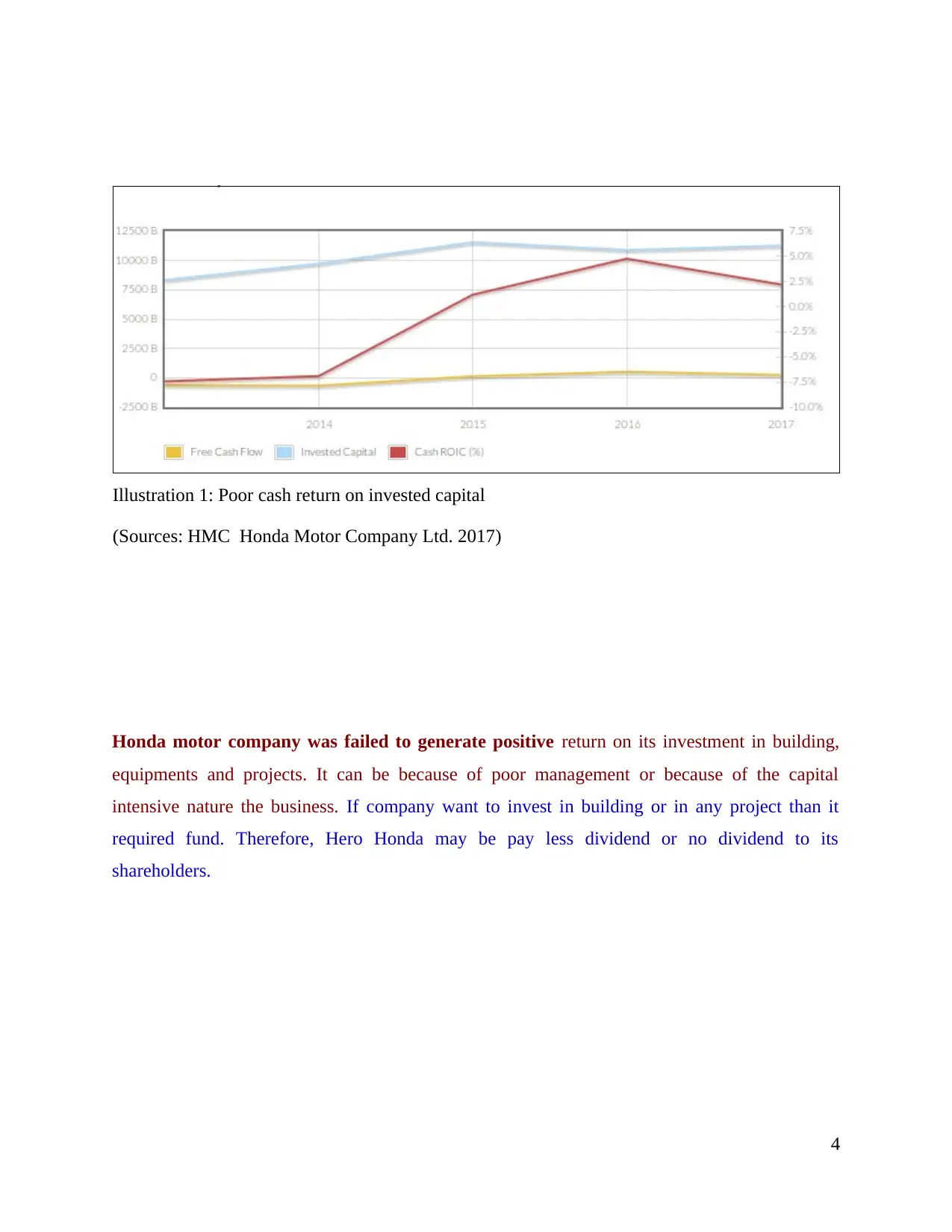
Honda motor company was failed to generate positive return on its investment in building,
equipments and projects. It can be because of poor management or because of the capital
intensive nature the business. If company want to invest in building or in any project than it
required fund. Therefore, Hero Honda may be pay less dividend or no dividend to its
shareholders.
4
Illustration 1: Poor cash return on invested capital
(Sources: HMC Honda Motor Company Ltd. 2017)
equipments and projects. It can be because of poor management or because of the capital
intensive nature the business. If company want to invest in building or in any project than it
required fund. Therefore, Hero Honda may be pay less dividend or no dividend to its
shareholders.
4
Illustration 1: Poor cash return on invested capital
(Sources: HMC Honda Motor Company Ltd. 2017)
You're viewing a preview
Unlock full access by subscribing today!

(Sources: HMC Honda Motor Company Ltd. 2017)
HMC is consistently distributing a dividend from the last 10 years. This long dividend history
assists in suggesting that HMC is very established in the market. Further, it can be stated that
dividend distribution is likely to proceed for the significant period of time
2008 2009 2010 2011 2012 2013 2014 2015 2016 2017
Divide
nd
paid
161.55
B
150.57
B
77.97B 108.40
B
123.90
B
136.02
B
152.06
B
180.11
B
158.60
B
162.21
B
Divided by
Shares
outsta
nding
1.81B 1.81B 1.81B 1.81B 1.80B 1.80B 1.80B 1.80B 1.80B 1.80B
Divide
nd
paid
per
share
1.08 1.00 0.52 0.72 0.83 0.91 1.02 1.21 1.06 1.09
Price
per
21.29 33.95 39.09 30.55 36.42 41.22 29.60 32.04 29.19 28.12
5
HMC is consistently distributing a dividend from the last 10 years. This long dividend history
assists in suggesting that HMC is very established in the market. Further, it can be stated that
dividend distribution is likely to proceed for the significant period of time
2008 2009 2010 2011 2012 2013 2014 2015 2016 2017
Divide
nd
paid
161.55
B
150.57
B
77.97B 108.40
B
123.90
B
136.02
B
152.06
B
180.11
B
158.60
B
162.21
B
Divided by
Shares
outsta
nding
1.81B 1.81B 1.81B 1.81B 1.80B 1.80B 1.80B 1.80B 1.80B 1.80B
Divide
nd
paid
per
share
1.08 1.00 0.52 0.72 0.83 0.91 1.02 1.21 1.06 1.09
Price
per
21.29 33.95 39.09 30.55 36.42 41.22 29.60 32.04 29.19 28.12
5
Paraphrase This Document
Need a fresh take? Get an instant paraphrase of this document with our AI Paraphraser
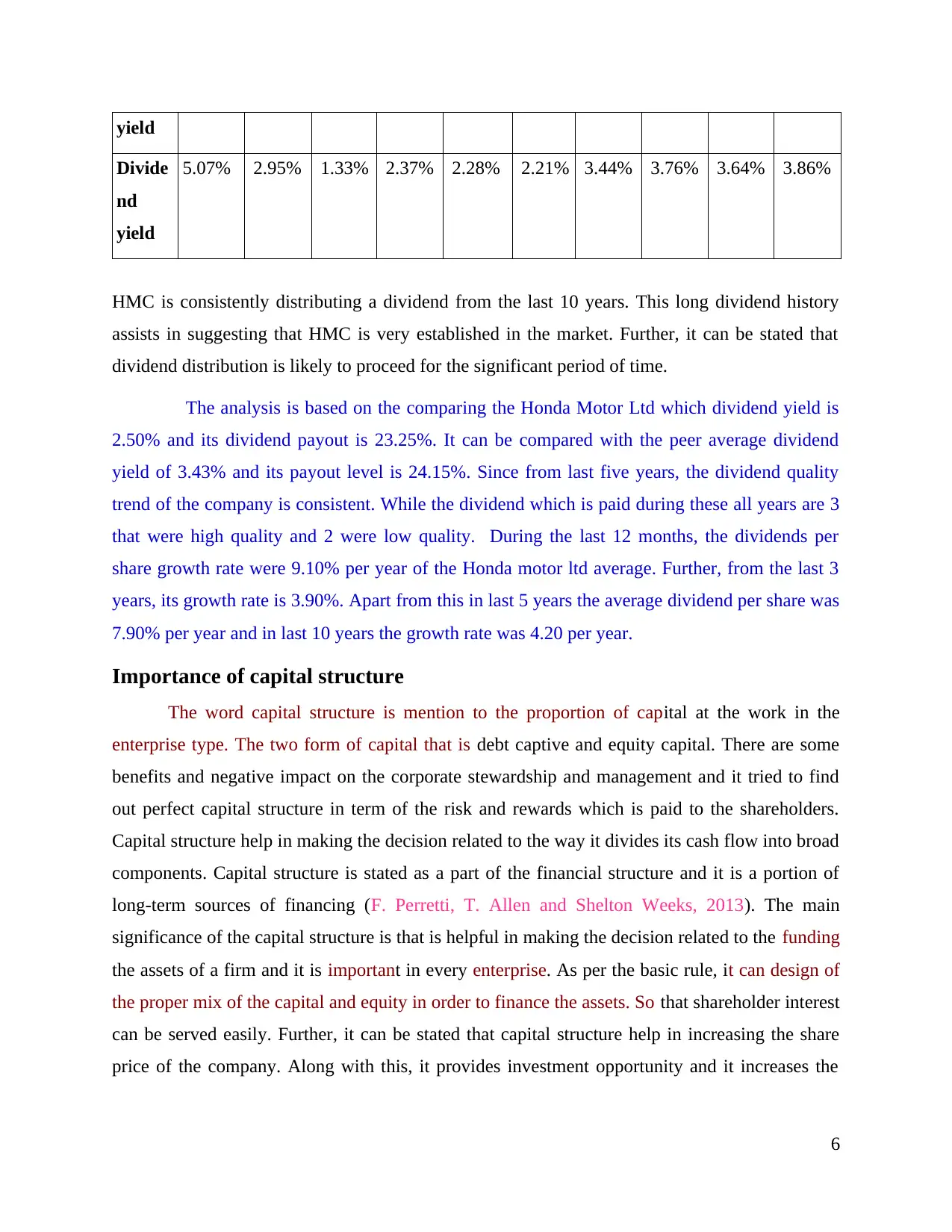
yield
Divide
nd
yield
5.07% 2.95% 1.33% 2.37% 2.28% 2.21% 3.44% 3.76% 3.64% 3.86%
HMC is consistently distributing a dividend from the last 10 years. This long dividend history
assists in suggesting that HMC is very established in the market. Further, it can be stated that
dividend distribution is likely to proceed for the significant period of time.
The analysis is based on the comparing the Honda Motor Ltd which dividend yield is
2.50% and its dividend payout is 23.25%. It can be compared with the peer average dividend
yield of 3.43% and its payout level is 24.15%. Since from last five years, the dividend quality
trend of the company is consistent. While the dividend which is paid during these all years are 3
that were high quality and 2 were low quality. During the last 12 months, the dividends per
share growth rate were 9.10% per year of the Honda motor ltd average. Further, from the last 3
years, its growth rate is 3.90%. Apart from this in last 5 years the average dividend per share was
7.90% per year and in last 10 years the growth rate was 4.20 per year.
Importance of capital structure
The word capital structure is mention to the proportion of capital at the work in the
enterprise type. The two form of capital that is debt captive and equity capital. There are some
benefits and negative impact on the corporate stewardship and management and it tried to find
out perfect capital structure in term of the risk and rewards which is paid to the shareholders.
Capital structure help in making the decision related to the way it divides its cash flow into broad
components. Capital structure is stated as a part of the financial structure and it is a portion of
long-term sources of financing (F. Perretti, T. Allen and Shelton Weeks, 2013). The main
significance of the capital structure is that is helpful in making the decision related to the funding
the assets of a firm and it is important in every enterprise. As per the basic rule, it can design of
the proper mix of the capital and equity in order to finance the assets. So that shareholder interest
can be served easily. Further, it can be stated that capital structure help in increasing the share
price of the company. Along with this, it provides investment opportunity and it increases the
6
Divide
nd
yield
5.07% 2.95% 1.33% 2.37% 2.28% 2.21% 3.44% 3.76% 3.64% 3.86%
HMC is consistently distributing a dividend from the last 10 years. This long dividend history
assists in suggesting that HMC is very established in the market. Further, it can be stated that
dividend distribution is likely to proceed for the significant period of time.
The analysis is based on the comparing the Honda Motor Ltd which dividend yield is
2.50% and its dividend payout is 23.25%. It can be compared with the peer average dividend
yield of 3.43% and its payout level is 24.15%. Since from last five years, the dividend quality
trend of the company is consistent. While the dividend which is paid during these all years are 3
that were high quality and 2 were low quality. During the last 12 months, the dividends per
share growth rate were 9.10% per year of the Honda motor ltd average. Further, from the last 3
years, its growth rate is 3.90%. Apart from this in last 5 years the average dividend per share was
7.90% per year and in last 10 years the growth rate was 4.20 per year.
Importance of capital structure
The word capital structure is mention to the proportion of capital at the work in the
enterprise type. The two form of capital that is debt captive and equity capital. There are some
benefits and negative impact on the corporate stewardship and management and it tried to find
out perfect capital structure in term of the risk and rewards which is paid to the shareholders.
Capital structure help in making the decision related to the way it divides its cash flow into broad
components. Capital structure is stated as a part of the financial structure and it is a portion of
long-term sources of financing (F. Perretti, T. Allen and Shelton Weeks, 2013). The main
significance of the capital structure is that is helpful in making the decision related to the funding
the assets of a firm and it is important in every enterprise. As per the basic rule, it can design of
the proper mix of the capital and equity in order to finance the assets. So that shareholder interest
can be served easily. Further, it can be stated that capital structure help in increasing the share
price of the company. Along with this, it provides investment opportunity and it increases the
6
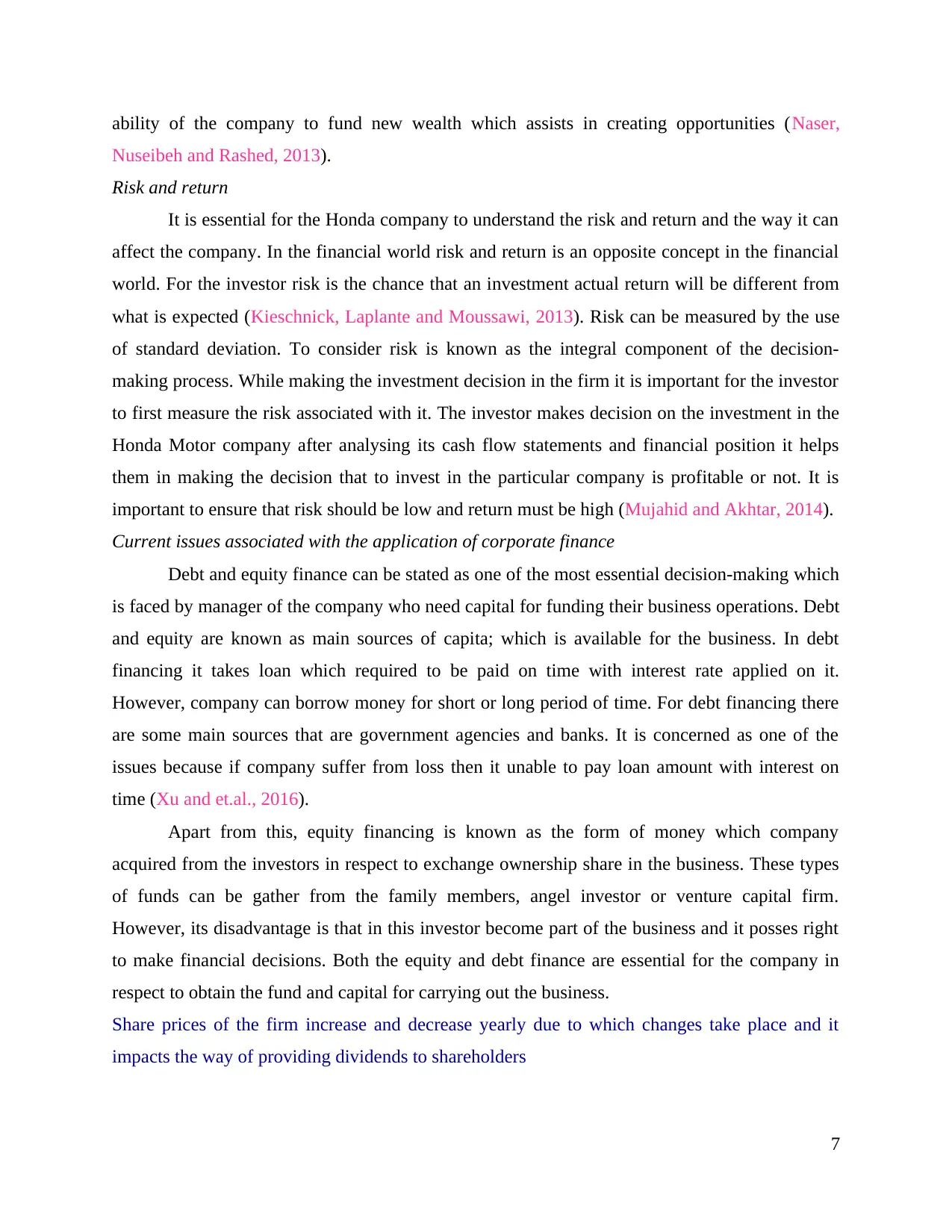
ability of the company to fund new wealth which assists in creating opportunities (Naser,
Nuseibeh and Rashed, 2013).
Risk and return
It is essential for the Honda company to understand the risk and return and the way it can
affect the company. In the financial world risk and return is an opposite concept in the financial
world. For the investor risk is the chance that an investment actual return will be different from
what is expected (Kieschnick, Laplante and Moussawi, 2013). Risk can be measured by the use
of standard deviation. To consider risk is known as the integral component of the decision-
making process. While making the investment decision in the firm it is important for the investor
to first measure the risk associated with it. The investor makes decision on the investment in the
Honda Motor company after analysing its cash flow statements and financial position it helps
them in making the decision that to invest in the particular company is profitable or not. It is
important to ensure that risk should be low and return must be high (Mujahid and Akhtar, 2014).
Current issues associated with the application of corporate finance
Debt and equity finance can be stated as one of the most essential decision-making which
is faced by manager of the company who need capital for funding their business operations. Debt
and equity are known as main sources of capita; which is available for the business. In debt
financing it takes loan which required to be paid on time with interest rate applied on it.
However, company can borrow money for short or long period of time. For debt financing there
are some main sources that are government agencies and banks. It is concerned as one of the
issues because if company suffer from loss then it unable to pay loan amount with interest on
time (Xu and et.al., 2016).
Apart from this, equity financing is known as the form of money which company
acquired from the investors in respect to exchange ownership share in the business. These types
of funds can be gather from the family members, angel investor or venture capital firm.
However, its disadvantage is that in this investor become part of the business and it posses right
to make financial decisions. Both the equity and debt finance are essential for the company in
respect to obtain the fund and capital for carrying out the business.
Share prices of the firm increase and decrease yearly due to which changes take place and it
impacts the way of providing dividends to shareholders
7
Nuseibeh and Rashed, 2013).
Risk and return
It is essential for the Honda company to understand the risk and return and the way it can
affect the company. In the financial world risk and return is an opposite concept in the financial
world. For the investor risk is the chance that an investment actual return will be different from
what is expected (Kieschnick, Laplante and Moussawi, 2013). Risk can be measured by the use
of standard deviation. To consider risk is known as the integral component of the decision-
making process. While making the investment decision in the firm it is important for the investor
to first measure the risk associated with it. The investor makes decision on the investment in the
Honda Motor company after analysing its cash flow statements and financial position it helps
them in making the decision that to invest in the particular company is profitable or not. It is
important to ensure that risk should be low and return must be high (Mujahid and Akhtar, 2014).
Current issues associated with the application of corporate finance
Debt and equity finance can be stated as one of the most essential decision-making which
is faced by manager of the company who need capital for funding their business operations. Debt
and equity are known as main sources of capita; which is available for the business. In debt
financing it takes loan which required to be paid on time with interest rate applied on it.
However, company can borrow money for short or long period of time. For debt financing there
are some main sources that are government agencies and banks. It is concerned as one of the
issues because if company suffer from loss then it unable to pay loan amount with interest on
time (Xu and et.al., 2016).
Apart from this, equity financing is known as the form of money which company
acquired from the investors in respect to exchange ownership share in the business. These types
of funds can be gather from the family members, angel investor or venture capital firm.
However, its disadvantage is that in this investor become part of the business and it posses right
to make financial decisions. Both the equity and debt finance are essential for the company in
respect to obtain the fund and capital for carrying out the business.
Share prices of the firm increase and decrease yearly due to which changes take place and it
impacts the way of providing dividends to shareholders
7
You're viewing a preview
Unlock full access by subscribing today!
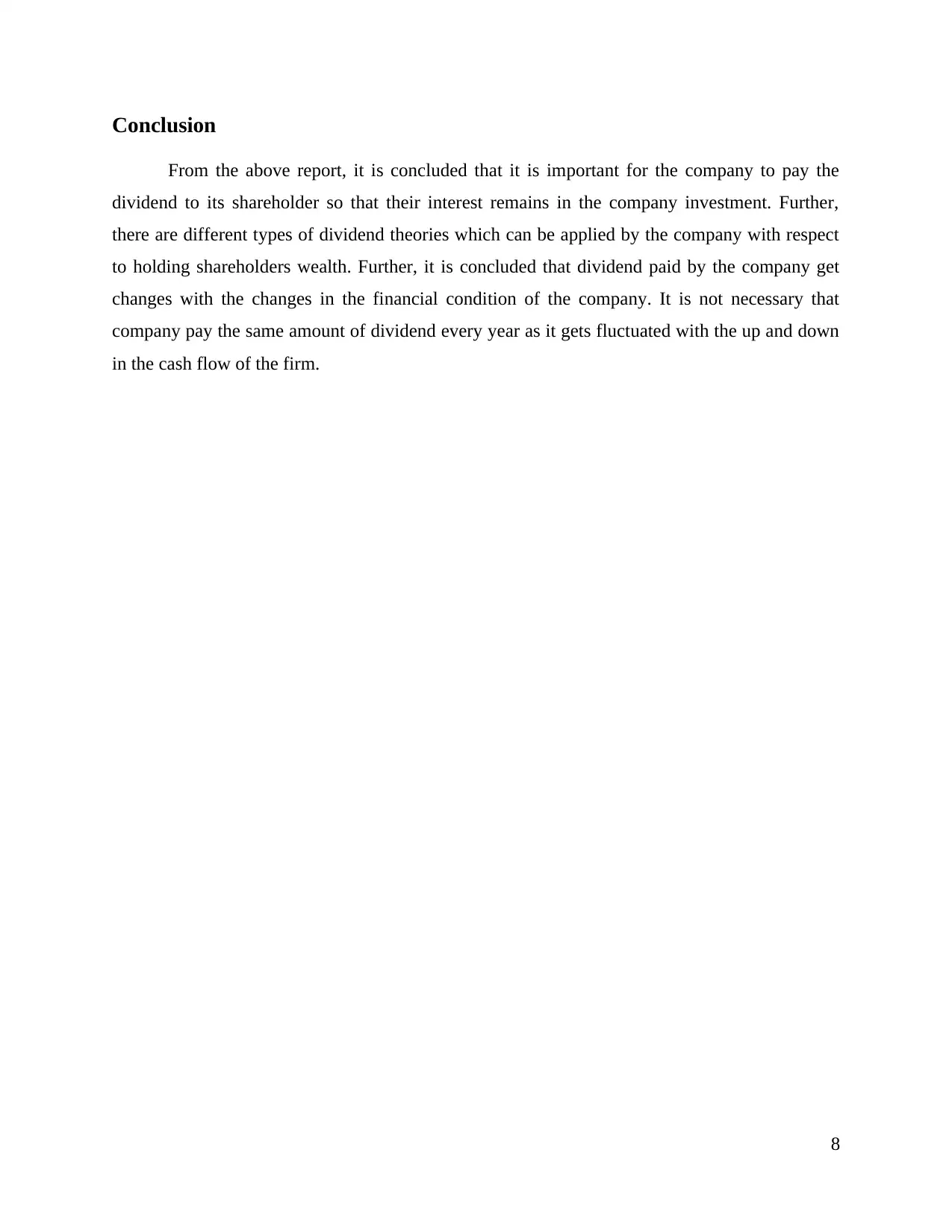
Conclusion
From the above report, it is concluded that it is important for the company to pay the
dividend to its shareholder so that their interest remains in the company investment. Further,
there are different types of dividend theories which can be applied by the company with respect
to holding shareholders wealth. Further, it is concluded that dividend paid by the company get
changes with the changes in the financial condition of the company. It is not necessary that
company pay the same amount of dividend every year as it gets fluctuated with the up and down
in the cash flow of the firm.
8
From the above report, it is concluded that it is important for the company to pay the
dividend to its shareholder so that their interest remains in the company investment. Further,
there are different types of dividend theories which can be applied by the company with respect
to holding shareholders wealth. Further, it is concluded that dividend paid by the company get
changes with the changes in the financial condition of the company. It is not necessary that
company pay the same amount of dividend every year as it gets fluctuated with the up and down
in the cash flow of the firm.
8
Paraphrase This Document
Need a fresh take? Get an instant paraphrase of this document with our AI Paraphraser
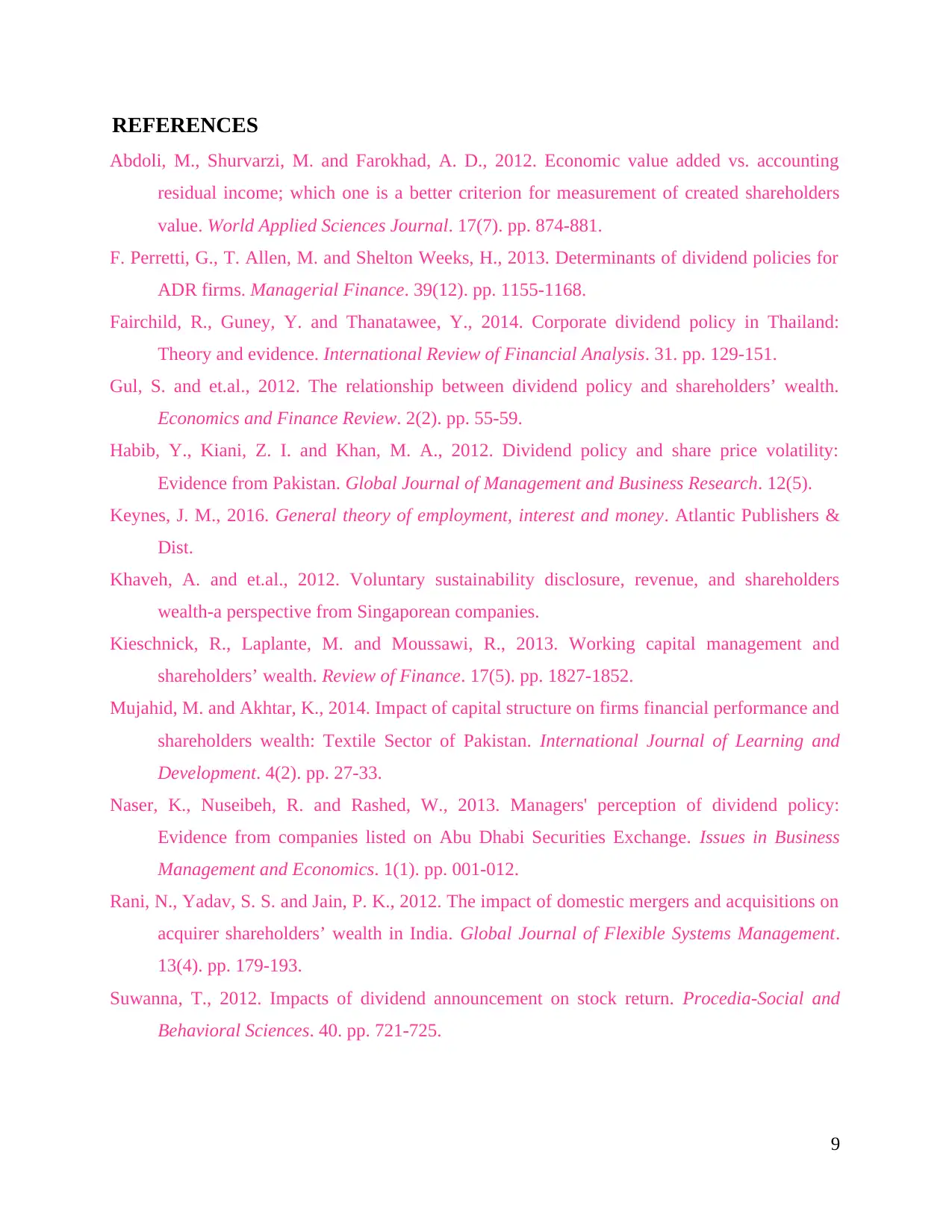
REFERENCES
Abdoli, M., Shurvarzi, M. and Farokhad, A. D., 2012. Economic value added vs. accounting
residual income; which one is a better criterion for measurement of created shareholders
value. World Applied Sciences Journal. 17(7). pp. 874-881.
F. Perretti, G., T. Allen, M. and Shelton Weeks, H., 2013. Determinants of dividend policies for
ADR firms. Managerial Finance. 39(12). pp. 1155-1168.
Fairchild, R., Guney, Y. and Thanatawee, Y., 2014. Corporate dividend policy in Thailand:
Theory and evidence. International Review of Financial Analysis. 31. pp. 129-151.
Gul, S. and et.al., 2012. The relationship between dividend policy and shareholders’ wealth.
Economics and Finance Review. 2(2). pp. 55-59.
Habib, Y., Kiani, Z. I. and Khan, M. A., 2012. Dividend policy and share price volatility:
Evidence from Pakistan. Global Journal of Management and Business Research. 12(5).
Keynes, J. M., 2016. General theory of employment, interest and money. Atlantic Publishers &
Dist.
Khaveh, A. and et.al., 2012. Voluntary sustainability disclosure, revenue, and shareholders
wealth-a perspective from Singaporean companies.
Kieschnick, R., Laplante, M. and Moussawi, R., 2013. Working capital management and
shareholders’ wealth. Review of Finance. 17(5). pp. 1827-1852.
Mujahid, M. and Akhtar, K., 2014. Impact of capital structure on firms financial performance and
shareholders wealth: Textile Sector of Pakistan. International Journal of Learning and
Development. 4(2). pp. 27-33.
Naser, K., Nuseibeh, R. and Rashed, W., 2013. Managers' perception of dividend policy:
Evidence from companies listed on Abu Dhabi Securities Exchange. Issues in Business
Management and Economics. 1(1). pp. 001-012.
Rani, N., Yadav, S. S. and Jain, P. K., 2012. The impact of domestic mergers and acquisitions on
acquirer shareholders’ wealth in India. Global Journal of Flexible Systems Management.
13(4). pp. 179-193.
Suwanna, T., 2012. Impacts of dividend announcement on stock return. Procedia-Social and
Behavioral Sciences. 40. pp. 721-725.
9
Abdoli, M., Shurvarzi, M. and Farokhad, A. D., 2012. Economic value added vs. accounting
residual income; which one is a better criterion for measurement of created shareholders
value. World Applied Sciences Journal. 17(7). pp. 874-881.
F. Perretti, G., T. Allen, M. and Shelton Weeks, H., 2013. Determinants of dividend policies for
ADR firms. Managerial Finance. 39(12). pp. 1155-1168.
Fairchild, R., Guney, Y. and Thanatawee, Y., 2014. Corporate dividend policy in Thailand:
Theory and evidence. International Review of Financial Analysis. 31. pp. 129-151.
Gul, S. and et.al., 2012. The relationship between dividend policy and shareholders’ wealth.
Economics and Finance Review. 2(2). pp. 55-59.
Habib, Y., Kiani, Z. I. and Khan, M. A., 2012. Dividend policy and share price volatility:
Evidence from Pakistan. Global Journal of Management and Business Research. 12(5).
Keynes, J. M., 2016. General theory of employment, interest and money. Atlantic Publishers &
Dist.
Khaveh, A. and et.al., 2012. Voluntary sustainability disclosure, revenue, and shareholders
wealth-a perspective from Singaporean companies.
Kieschnick, R., Laplante, M. and Moussawi, R., 2013. Working capital management and
shareholders’ wealth. Review of Finance. 17(5). pp. 1827-1852.
Mujahid, M. and Akhtar, K., 2014. Impact of capital structure on firms financial performance and
shareholders wealth: Textile Sector of Pakistan. International Journal of Learning and
Development. 4(2). pp. 27-33.
Naser, K., Nuseibeh, R. and Rashed, W., 2013. Managers' perception of dividend policy:
Evidence from companies listed on Abu Dhabi Securities Exchange. Issues in Business
Management and Economics. 1(1). pp. 001-012.
Rani, N., Yadav, S. S. and Jain, P. K., 2012. The impact of domestic mergers and acquisitions on
acquirer shareholders’ wealth in India. Global Journal of Flexible Systems Management.
13(4). pp. 179-193.
Suwanna, T., 2012. Impacts of dividend announcement on stock return. Procedia-Social and
Behavioral Sciences. 40. pp. 721-725.
9
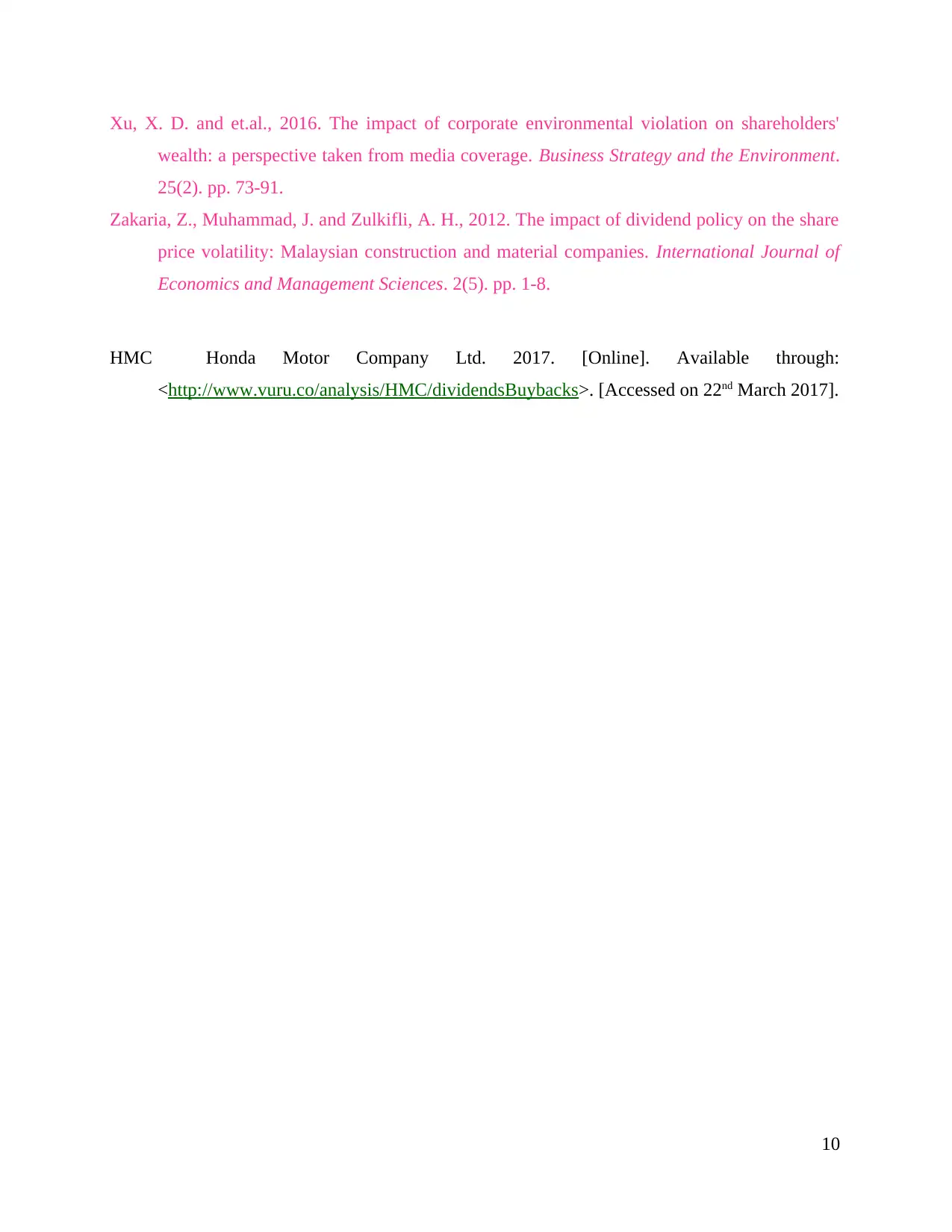
Xu, X. D. and et.al., 2016. The impact of corporate environmental violation on shareholders'
wealth: a perspective taken from media coverage. Business Strategy and the Environment.
25(2). pp. 73-91.
Zakaria, Z., Muhammad, J. and Zulkifli, A. H., 2012. The impact of dividend policy on the share
price volatility: Malaysian construction and material companies. International Journal of
Economics and Management Sciences. 2(5). pp. 1-8.
HMC Honda Motor Company Ltd. 2017. [Online]. Available through:
<http://www.vuru.co/analysis/HMC/dividendsBuybacks>. [Accessed on 22nd March 2017].
10
wealth: a perspective taken from media coverage. Business Strategy and the Environment.
25(2). pp. 73-91.
Zakaria, Z., Muhammad, J. and Zulkifli, A. H., 2012. The impact of dividend policy on the share
price volatility: Malaysian construction and material companies. International Journal of
Economics and Management Sciences. 2(5). pp. 1-8.
HMC Honda Motor Company Ltd. 2017. [Online]. Available through:
<http://www.vuru.co/analysis/HMC/dividendsBuybacks>. [Accessed on 22nd March 2017].
10
You're viewing a preview
Unlock full access by subscribing today!
1 out of 12
Related Documents
Your All-in-One AI-Powered Toolkit for Academic Success.
+13062052269
info@desklib.com
Available 24*7 on WhatsApp / Email
![[object Object]](/_next/static/media/star-bottom.7253800d.svg)
Unlock your academic potential
© 2024 | Zucol Services PVT LTD | All rights reserved.





